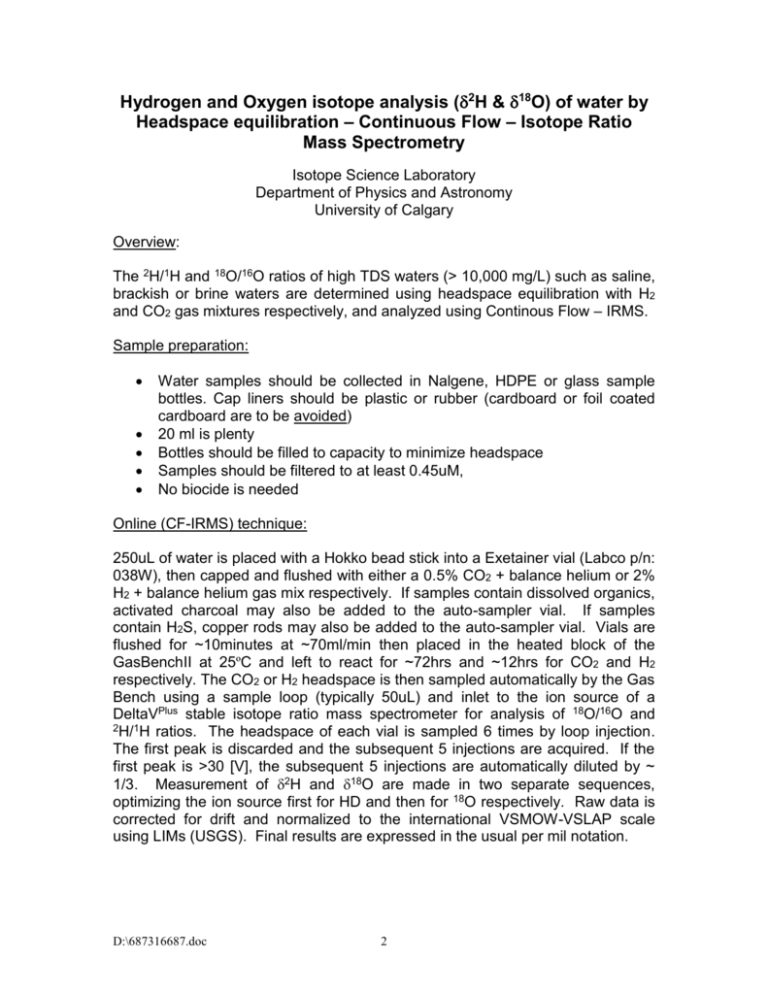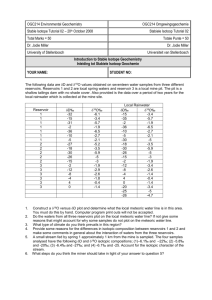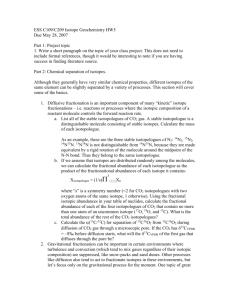HD and 18/16O of water by CF-GB-IRMS
advertisement

Hydrogen and Oxygen isotope analysis (2H & 18O) of water by Headspace equilibration – Continuous Flow – Isotope Ratio Mass Spectrometry Isotope Science Laboratory Department of Physics and Astronomy University of Calgary Overview: The 2H/1H and 18O/16O ratios of high TDS waters (> 10,000 mg/L) such as saline, brackish or brine waters are determined using headspace equilibration with H2 and CO2 gas mixtures respectively, and analyzed using Continous Flow – IRMS. Sample preparation: Water samples should be collected in Nalgene, HDPE or glass sample bottles. Cap liners should be plastic or rubber (cardboard or foil coated cardboard are to be avoided) 20 ml is plenty Bottles should be filled to capacity to minimize headspace Samples should be filtered to at least 0.45uM, No biocide is needed Online (CF-IRMS) technique: 250uL of water is placed with a Hokko bead stick into a Exetainer vial (Labco p/n: 038W), then capped and flushed with either a 0.5% CO2 + balance helium or 2% H2 + balance helium gas mix respectively. If samples contain dissolved organics, activated charcoal may also be added to the auto-sampler vial. If samples contain H2S, copper rods may also be added to the auto-sampler vial. Vials are flushed for ~10minutes at ~70ml/min then placed in the heated block of the GasBenchII at 25ºC and left to react for ~72hrs and ~12hrs for CO2 and H2 respectively. The CO2 or H2 headspace is then sampled automatically by the Gas Bench using a sample loop (typically 50uL) and inlet to the ion source of a DeltaVPlus stable isotope ratio mass spectrometer for analysis of 18O/16O and 2H/1H ratios. The headspace of each vial is sampled 6 times by loop injection. The first peak is discarded and the subsequent 5 injections are acquired. If the first peak is >30 [V], the subsequent 5 injections are automatically diluted by ~ 1/3. Measurement of 2H and 18O are made in two separate sequences, optimizing the ion source first for HD and then for 18O respectively. Raw data is corrected for drift and normalized to the international VSMOW-VSLAP scale using LIMs (USGS). Final results are expressed in the usual per mil notation. D:\687316687.doc 2 Further comments on technique: Normalization standards are used throughout the sequence to correct for drift Internal lab standards are analyzed repeatedly within each sequence at approximately 1 standard per every 7 unknowns Mass Spectrometric Measurements: The “raw” 2HH2Oand18OH2O values are normalized using internal, laboratory water standards which are have been calibrated against International reference materials: VSMOW, VSLAP & VGISP. All internal lab standards are periodically checked against fresh VSMOW, VSLAP & VGISP USGS LIMs is used for drift correction, normalization and data management (http://water.usgs.gov/software/LIMS/). Corrected 2HH2Oand18OH2O values are reported in the usual per mil (‰) notation Accuracy and Precision: Accuracy and precision of 2H determinations are generally better than 4.0‰ (one standard deviation based on n=50 lab standard). Accuracy and precision of 18O determinations are generally better than 0.2‰ (one standard deviation based on n=50 lab standard). References: R.A. Werner and W.A. Brand, Referencing strategies and techniques in stable isotope ratio analysis, Rapid Communications in Mass Spectrometry, 2001: 15: 501-519 Hilkert A.W., et al., Thermo application note: 30048, 18O-Equilibration on Water, Fruit Juice and Wine Using Thermo Scientific GasBench II Duhr A, et al., Thermo application note: 30049, Automated H2/H2O Equilibration for δD Determination on Aqueous Samples Using Thermo Scientific GasBench II D:\687316687.doc 2











